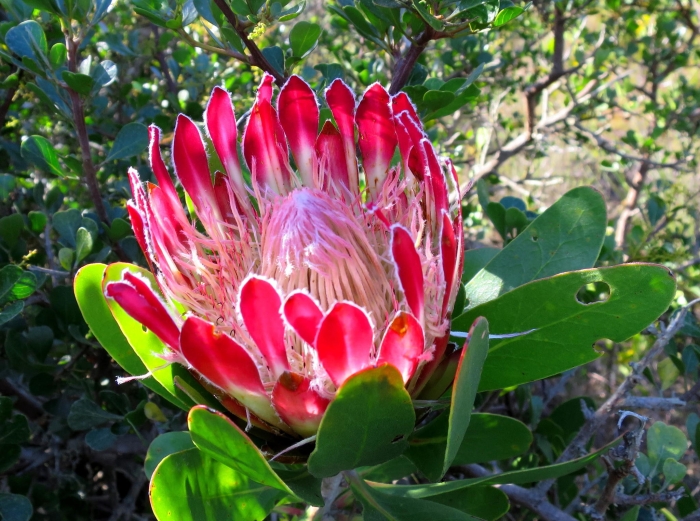Limestone Sugarbush
(Protea obtusifolia)
Limestone Sugarbush (Protea obtusifolia)
/
/

Di Turner
Public Domain
Image By:
Di Turner
Recorded By:
Copyright:
Public Domain
Copyright Notice:
Photo by: Di Turner | License Type: Public Domain | License URL: http://creativecommons.org/publicdomain/zero/1.0/ | Rights Holder: Di Turner | Publisher: iNaturalist | Date Created: 42565 |












































Estimated Native Range
Summary
Protea obtusifolia, commonly known as Limestone Sugarbush, is an evergreen shrub native to the limestone-rich fynbos and coastal plains of southwestern South Africa. It typically grows to a height and width of 6-8 feet (1.8-2.4 meters), with a rounded and bushy habit. The plant is characterized by its large, striking flowers that come in shades of red, white, and pink, blooming from late winter to summer. The blooms are exceptionally showy and make the plant a focal point in any garden. The foliage is leathery and blue-green, adding to the plant’s visual interest throughout the year.
Limestone Sugarbush is valued for its drought tolerance and its ability to thrive in nutrient-poor soils, making it a suitable choice for water-wise gardens and xeriscaping. It is often used in ornamental plantings, as a specimen plant, or in mixed shrub borders. Protea obtusifolia requires full sun exposure and well-drained soil to flourish. While it is generally low maintenance, it can be susceptible to root rot if overwatered or planted in poorly drained soils. It is also sensitive to phosphorus, so fertilizers for proteas should be selected carefully. In regions where it is non-native, care should be taken to prevent it from becoming invasive.CC BY-SA 4.0
Limestone Sugarbush is valued for its drought tolerance and its ability to thrive in nutrient-poor soils, making it a suitable choice for water-wise gardens and xeriscaping. It is often used in ornamental plantings, as a specimen plant, or in mixed shrub borders. Protea obtusifolia requires full sun exposure and well-drained soil to flourish. While it is generally low maintenance, it can be susceptible to root rot if overwatered or planted in poorly drained soils. It is also sensitive to phosphorus, so fertilizers for proteas should be selected carefully. In regions where it is non-native, care should be taken to prevent it from becoming invasive.CC BY-SA 4.0
Plant Description
- Plant Type: Shrub
- Height: 6-8 feet
- Width: 6-8 feet
- Growth Rate: Moderate
- Flower Color: Red, White, Pink
- Flowering Season: Spring, Summer
- Leaf Retention: Evergreen
Growth Requirements
- Sun: Full Sun
- Water: Low, Medium
- Drainage: Medium
Common Uses
Bee Garden, Bird Garden, Butterfly Garden, Drought Tolerant, Hummingbird Garden, Low Maintenance, Showy Flowers
Natural Habitat
Native to the limestone-rich fynbos and coastal plains of southwestern South Africa
Other Names
Common Names:
Scientific Names: , Protea obtusifolia, Protea calocephala, Scolymocephalus calocephalus, Scolymocephalus obtusifolius,
GBIF Accepted Name: Protea obtusifolia H.Buek ex Meisn.